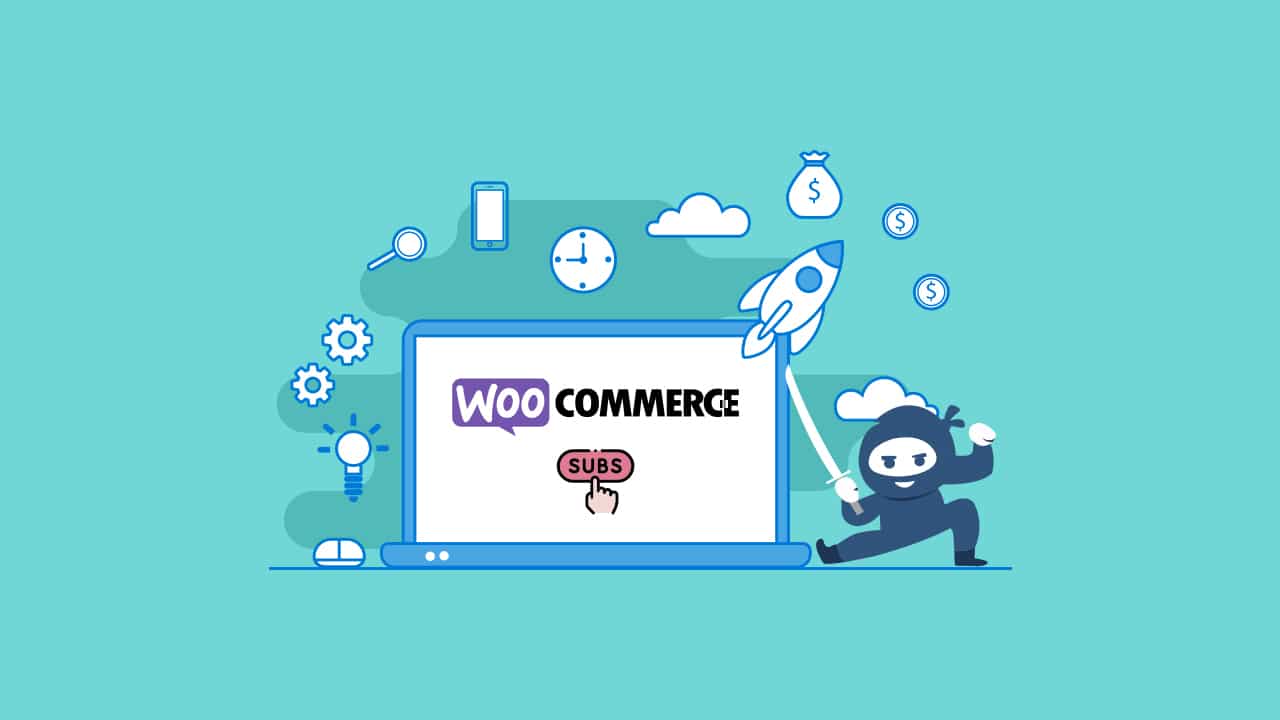WooCommerce is one of the most widely used eCommerce platforms for setting up an online store. It is a free, open-source WordPress plugin that lets users quickly create an online store and sell various goods, including digital products like online courses.
However, for most course creators, WooCommerce is not enough on its own. A Learning Management System (LMS) is an essential tool for the creation of online courses. It also helps instructors manage and deliver courses to their students. You can then sell these courses by integrating your LMS with an eCommerce platform like WooCommerce. In this article, we’ll show you how.
We will begin by discussing what WooCommerce is and how it works and walk you through the process for setting up your online course business. We’ll also go over the benefits of using WooCommerce to sell your courses, such as its ease of use, versatility, and cost-effectiveness, and show you how to link WooCommerce with your learning management system so your students can access your courses directly from your store.
By the end of this article, you will clearly understand how to use WooCommerce and your LMS to sell your courses online. This will not only help you reach a larger audience, but it will also give your students a seamless buying and learning experience.
Setting up WooCommerce
WooCommerce is an open-source, eCommerce plugin for WordPress that enables users to quickly set up an online store and sell a range of products, including digital products like online courses. It is built on the popular WordPress content management system, and so it inherits all of WordPress’s features, such as the ability to create pages and posts and manage users and permissions.
From the WordPress dashboard, users can manage their products, orders, and clients using WooCommerce. It has built-in support for a variety of payment processors, such as PayPal and Stripe, as well as shipping choices and tax settings. Because of this, setting up and managing your online store is simple and doesn’t require a deep grasp of eCommerce or web programming.
WooCommerce offers users a range of customization tools so they can customize the look and feel of their store to better represent their brand. It also offers a variety of other features, such as support for several languages, inventory management, and connectivity with popular shipping and tax plugins. In addition, it offers thorough reporting and analytics that can aid users in comprehending the success of their stores and in making fact-based decisions.
WooCommerce is an all-around user-friendly and adaptable eCommerce platform that is suitable for small to medium-sized online businesses. Users can do this without having a lot of technical knowledge and easily set up an online store to sell their products. It is excellent for online educators wishing to sell their courses online because of its extensive feature set and customization choices.
The process to install and set up WooCommerce on a website are as follows:
Install WordPress:
Installing WordPress on your website is the first step in configuring WooCommerce. If you haven’t already, you can download and install WordPress from the official website. After installation, you will have a basic WordPress website that is ready for customization.
Install the WooCommerce Plugin:
After installing WordPress, you must install the WooCommerce plugin. You can add it to your website after downloading it for free from the WordPress repository.
Even simpler, you can do it directly from your WordPress dashboard. You can do this by searching for “WooCommerce” in the Plugins area of your WordPress dashboard. To install and activate the plugin, click “Install.” Wait a moment while the plugin installs. then press the “Activate” button. Your WordPress dashboard will display a new menu option called “WooCommerce” when the plugin has been installed.
Run the Setup Wizard:
When the WooCommerce plugin is activated, you’ll be asked to launch the setup process. You will be led step-by-step through the process of setting up your store by the wizard, which will also walk you through configuring your shipping and payment choices. It will ask you for some fundamental store information, such as the address and currency you intend to use.
Customize Your Store:
By visiting the Appearance section of your WordPress dashboard, you can change the look and feel of your store. You can pick a theme, change the colors, and more here. You can also use a few of the WooCommerce themes that are offered, which were created especially for online shops. By making your store more unique, you may improve its use and appeal.
You can properly set up and configure your WooCommerce store by following these steps, and you will then be ready to start selling your online courses. Please feel free to contact our WooCommerce experts if you run into any difficulties during the setup process.
Configure Your Products:
Finally, you will need to configure your products, which in this case will be your online courses. The process for creating products that contain your LMS courses will vary depending on the LMS being used.
Why Is WooCommerce Integration Important for Your LMS Platform?
WooCommerce is a plugin that makes it simple and affordable to start selling anything online, including courses. While many learning management systems have built-in monetization features, allowing you to receive payments for your courses, most of them offer limited e-commerce features.
This is the point where WooCommerce and LMS converge.
1. Selling Courses & Products:
You may automate the distribution of your courses to students by integrating your LMS with WooCommerce. When a student purchases a course, they will have automatic access to it in your LMS, eliminating the need for manual enrolment.
The ability to easily sell your courses from your website is one of the key advantages of integrating WooCommerce with your LMS. It also gives you, the seller, access to many different resources to sell and market your courses. For example, WooCommerce allows you to offer discount codes, set up upsells and cross-sells for your courses, and more.
This simplifies purchases for your students and makes your courses more attractive.
Using WooCommerce to set up products and accept payments is the best choice if you want to sell merchandise or learning materials from your eLearning WooCommerce platform.
2. Bundle Courses:
You can combine several courses and sell them as a package when you integrate WooCommerce with your learning management system. As students are more likely to buy many courses at a discounted price than if they were sold separately, this can be a successful strategy for boosting sales. The creation of a bundle of courses related to a certain career path or industry is one example of how bundle deals can be used to target particular audiences.
Related read: How to create course bundles using LearnDash and WooCommerce.
3. Subscription-Based Courses:
The possibility to develop subscription-based courses is another benefit of integrating WooCommerce with your LMS. For courses that are updated frequently or for continuous instruction, this can be extremely helpful. You can charge students regularly with WooCommerce’s recurring payment option, making it simple for them to access new content as it becomes available.
Related read: How To Use The WooCommerce Subscriptions To Sell LearnDash Courses
4. Managing Payments:
You can set up several payment methods with WooCommerce. This makes paying for your courses simple for students, regardless of what their chosen method of payment is. WooCommerce also offers thorough analytics and reporting on your sales, clients, and products, making it simple to keep track of payments and manage your finances.
Additionally, you can base your customer relationship management (CRM) operations on the sales data from WooCommerce. You can simply determine who you can upsell to, who are the most frequent buyers, who have left something at the checkout, and who need a discount.
5. Customizable Pricing:
With WooCommerce, you can set varying rates for individual courses while also offering discounts, sales, and other features. This might help develop pricing tactics to boost sales, such as providing a discount for early participants or putting together a package of courses at a discounted fee. Additionally, you may set up several pricing choices using the plugin for various consumer demographics, such as providing discounts for students or businesses buying in bulk.
6. Detailed Reporting and Analytics:
WooCommerce offers in-depth statistics and analytics on your sales, clients, and products, as was previously mentioned. This can assist you in making data-driven decisions about your course offerings and pricing, such as determining which courses are the most popular, the most successful pricing methods, and the most successful marketing campaigns.
7. Marketing and Promotion:
WooCommerce provides built-in SEO features as well as integration with popular marketing tools such as email marketing software, which can help you promote and sell your courses. For instance, you can use SEO to increase the exposure of your courses in search engines or email marketing to offer targeted promotions and discounts to your current students. It also helps you add product reviews to your courses, set up related product recommendations and upsells.
8. Better Security:
Your student’s sensitive information, including credit card numbers, personal information, and other data, can be kept secure with the help of WooCommerce integration. WooCommerce includes built-in security mechanisms and adheres to high industry standards to ensure safe and secure transactions.
You can make use of the eCommerce platform’s features and functions by integrating WooCommerce with your LMS, making it easier to sell your courses, manage payments and student information, and provide a smooth experience for your students. This can boost your income, enhance the learning experience for students, and expand your online education business.
Integrating an LMS with WooCommerce
A learning management system or LMS is a software application used for the administration, documenting, tracking, reporting, and delivery of educational courses, training programs, or learning and development programs. Using an LMS, educators can manage student data, track student progress, and create and deliver the material. Additionally, it offers a forum for interaction between teachers and students as well as access to course materials and tests.
Consider a learning management system as technology that can enhance learning and make it more efficient, effective, and, most importantly, trackable.
A core functional platform is present in even the most basic LMS, allowing administrators to upload learning materials, teach courses to students, send out notifications, and share data with authorized users.
Most frequently, an LMS runs in a web browser and requires secure sign-in. Administrators and leaders can track student progress and implement adjustments while giving all students and instructors convenient access to courses while on the go.
A basic LMS feature set consists of:
- Teachers can design, manage, and arrange their courses using tools for course creation and management.
- Tools for delivering content that let teachers upload and distribute course materials like text, audio, and video.
- Tools for assessment and testing enable teachers to design and deliver tests and quizzes, as well as monitor student progress.
- Tools for collaboration and communication that provide built-in forums and messaging services for educators and students to converse and work together.
- Detailed data on student progress, engagement, and completion rates are provided by reporting and analytics.
A learning management system can give numerous advantages to your business. The ultimate aim is to guarantee that every student has a learning experience that respects their preferred learning style.
An LMS improves the flexibility and originality of learning resources, which improves the student experience and facilitates collaborative learning. To better leverage how people naturally learn, student progression through classes and exams becomes more self-driven.
Different LMS Plugins That Integration With WooCommerce
A variety of learning management system (LMS) plugins are available to integrate with WooCommerce.
We have put together a list of the top three WooCommerce LMS plugins that will make it easy for you to create and administer your online courses while providing your audience with a wholly immersive learning experience.
Let’s look at the top three WooCommerce LMS plugins that can help you achieve these objectives for your website now that you understand what LMS plugins are and how they can help you give excellent content and a fantastic learning experience to your audience.
1. LearnDash:
LearnDash is a robust WordPress LMS plugin that lets you simply develop and sell courses on your website. It is perfect for creating and marketing certification courses since it includes an integrated certification and point system.
LearnDash gives you a lot of flexibility to build a variety of courses for your WordPress website. It is one of the LMS solutions that many universities, businesses, and entrepreneurs prefer. The plugin enables you to efficiently manage learners and create courses, quizzes, and courses.
You will also be able to build a reward system for good learning and check detailed course reports. Additionally, you will be able to drip content, which allows you to schedule periodic content access.
LearnDash provides a lot of flexibility in terms of managing course content and scheduling on the site, as well as dealing with learners. Additionally, LearnDash and WooCommerce work perfectly together, facilitating course selling and a variety of payment processors.
Additionally, the multimedia capability of this plugin enables you to build engaging classes using a variety of content types, including images, videos, and audio.
The gamification feature of this LMS plugin is another intriguing feature. After completing a set number of courses, your learners can earn points and, after they have accumulated enough points, can unlock free content and courses.
The plugin also has a wide library of incredible LearnDash add-ons to take your courses to the next level. For example, they can help you improve your quizzes, schedule your courses, generate quiz reports, verify certificates, and much more.
Pricing: The basic plan costs $199 per year and comes with a 15-day money-back guarantee.
2. LifterLMS:
LifterLMS is a comprehensive WordPress LMS plugin that lets you develop, administer, and sell courses on your website. It offers tools for creating courses, quizzes, and analytics. Additionally, it comes with an integrated payment gateway and membership system that make it simple to sell courses and memberships on your website. It also includes an integrated CRM system that makes managing customers and students easy.
The drag-and-drop course builder will enable you to create effective educational content. LifterLMS will be a fantastic choice for creating a variety of courses with varying sizes and structures.
It’s easy to add lessons, modules, and multimedia course components including text, audio, video, and images. Other fascinating features include providing study materials that can be downloaded for offline studying and putting timers on the quizzes that are used to assess your course participants’ knowledge.
You can restrict access to your course materials to only registered users by using password management.
Like with other WordPress LMS, LifterLMS can integrate a variety of popular tools into the WordPress environment including WooCommerce. One of the cool features you get with the integration is “Members Only” products, which can only be purchased by logged-in users who belong to a specific LifterLMS Membership.
You can also find add-ons for this LMS allowing you to expand on the functionality of the plugin.
Pricing: the LifterLMS WooCommerce add-on is priced at $149 for the basic plan. It also includes a 30-day demo for just $1.
3. TutorLMS:
TutorLMS is another WordPress LMS plugin that lets you create, manage, and sell courses on your site. It offers tools for creating courses, quizzes, and analytics.
Something unique about TutorLMS is that is offers a front-end course builder. This allows instructors to create their courses without having to learn how to navigate the WordPress dashboard, making course creation as easy as can be.
On Tutor LMS, you can sell your courses and permit other teachers to make their courses. You can also directly enable WooCommerce as your eCommerce course platform from the monetization settings. You can also enhance your platform further with third-party add-ons.
Tutor LMS is highly generous with its free version when compared to other LMS plugins available on the market. You can use a few of the tools it provides to build custom courses and monetize them using WooCommerce.
Pricing: The plugin offers a free plan for the basic package, but it starts pricing at $199/yr for the individual package.
Steps to Integrate Your LMS with WooCommerce – Using LearnDash
The LearnDash main functionalities might provide for the absolute necessities, but when compared to the options provided by specialized eCommerce plugins, they fall short in many ways.
The LearnDash WooCommerce integration is the perfect solution,, giving course designers access to a variety of expert marketing and sales options.
LearnDash excels at what it does since it was created primarily to create online courses. Additionally, it offers ways to pay for those courses, which is a supplementary feature.
On the other hand, WooCommerce was made specifically to market and sell goods and services, including digital goods like online courses. Its sole function is eCommerce, making it one of the most effective and suitable solutions in this market.
When it comes to eCommerce, employing LearnDash alone is similar to selecting a jack-of-all-trades; it’s best for those searching for a lightweight site but has very few features. Instead, you can sell your online courses using the best set of eCommerce tools.
Even while setting up WooCommerce requires a little extra work, the extra features are well worth it. In addition, you can always get assistance from the expert WooCommerce Developers at WooNinjas if you are uncertain about completing the process on your own.
Here’s what you need to know about integrating WooCommerce with LearnDash.
1. Install and Activate LearnDash and WooCommerce:
The first step is to make sure that WooCommerce and LearnDash are both installed and active on your WordPress website.
If you require any more assistance with the initial LMS configuration procedure, you can consult a LearnDash expert.
After that, install the WooCommerce for LearnDash add-on and activate it. It is available for free download from the Add-ons tab of the LearnDash menu on your WordPress dashboard.
2. Create a Course in LearnDash:
You will have a new menu item called “LearnDash LMS” in your WordPress dashboard once LearnDash has been activated. You can create a new course by going to this menu. Complete the course information, including the title, description, and other details.
3. Create a Product in WooCommerce:
Next, create a new product by going to the WooCommerce menu in your WordPress dashboard. This product will be used to sell your course. Include the product’s name, description, and price in your entry.
4. Connect the Course to the Product:
You can find the “Course Access Settings” section by visiting the LearnDash course you just created and scrolling down. You can choose to “Sell this course using WooCommerce” from this menu. From the drop-down menu, choose the new product you created.
5. Configure the Product options:
Scroll down to the “Product Data” section of the WooCommerce product you just created. You will find a selection for “Virtual” under the “General” tab. Select this choice, then save your modifications.
6. Set up the Payment Gateway:
Select the “Payments” option under WooCommerce settings in your WordPress dashboard. You can configure the payment gateway you intend to use to sell your course here. Ensure that the settings for your chosen gateway are configured.
Using the many options at your disposal, you can customize your course WooCommerce product page just like you would any other product page. Your creativity is the only constraint in this situation, from adding related courses and products area to order bumps, product reviews, and videos.
At this point, you can also start making use of all the additional opportunities provided by WooCommerce, including creating a sales funnel for your courses, personalizing your checkout page, or even promoting a physical product by using a free course as a lead magnet.
WooCommerce LMS integration
Integrating WooCommerce with your LMS platform can help your eLearning business in a variety of ways. You can manage all of your customers, orders, and products in one place, sell your courses directly on your website, and brand-consistently change the appearance and feel of your store.
The eLearning sector offers social impact, financial success, and most crucially, a low barrier to entry for anyone with information to impart and a functional internet connection. Almost anyone can start selling an online course with the correct tools and resources.
Our WooCommerce experts are here to provide guidance and assist you in identifying the best solutions for enhancing your online courses, boosting course revenues, and expanding your eLearning business. Contact us whenever you need a consultation.



